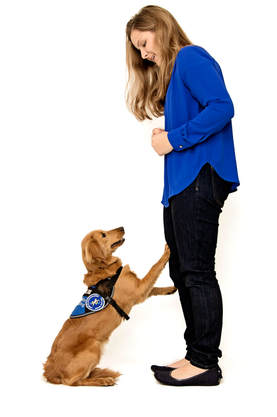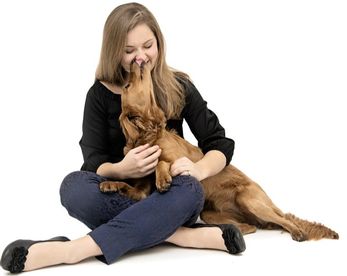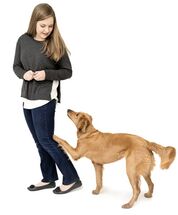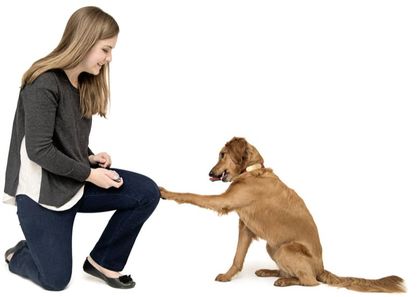Diabetic Alert Dog FAQs
What is a DAD?
DAD stands for diabetic alert dog - a type of service dog. DADs alert a person to low and/or high blood sugar.
DAD stands for diabetic alert dog - a type of service dog. DADs alert a person to low and/or high blood sugar.
How does a DAD detect blood sugar changes?
Dogs detect the change through their excellent sense of smell. The dogs can smell the chemical changes in a diabetic's spit, sweat, and other bodily fluids. Sometimes even people are able to smell the somewhat sweet scent of a diabetic's breath when they are extremely high. But dogs can detect this at a much lower, safer blood sugar level. And more importantly, they are able to smell the low blood sugar which we are not able to detect. We are not sure what low blood sugar smells like, but it may be similar to the smell of acetone. Although some scientists are still skeptical, a study showing the reliability and accuracy of the dogs was done in the UK and can be found here: http://www.plosone.org/article/info%3Adoi%2F10.1371%2Fjournal.pone.0069921
Dogs detect the change through their excellent sense of smell. The dogs can smell the chemical changes in a diabetic's spit, sweat, and other bodily fluids. Sometimes even people are able to smell the somewhat sweet scent of a diabetic's breath when they are extremely high. But dogs can detect this at a much lower, safer blood sugar level. And more importantly, they are able to smell the low blood sugar which we are not able to detect. We are not sure what low blood sugar smells like, but it may be similar to the smell of acetone. Although some scientists are still skeptical, a study showing the reliability and accuracy of the dogs was done in the UK and can be found here: http://www.plosone.org/article/info%3Adoi%2F10.1371%2Fjournal.pone.0069921
What does the alert look like?
There are multiple methods of alerting, including the following: nose bump on person's leg, paw the handler, jump up on the handler, bark, or pull a bringsel from the handler's belt loop or the its own collar.
There are multiple methods of alerting, including the following: nose bump on person's leg, paw the handler, jump up on the handler, bark, or pull a bringsel from the handler's belt loop or the its own collar.
Below are two videos of DADs alerting - one method is by placing her paws on the diabetic and the other video shows the dog pulling a bringsel, then pawing.
|
|
|
How accurate are DADs?
The accuracy between dogs varies, but a well trained DAD can be 80% - 90% accurate. They will miss alerts, sometimes they get tired or are distracted, sometimes the air isn't circulating in a way that they detect the scent, etc. There are many variables affecting a dog's alert. But, overall they can be quite accurate.
If I get a DAD can I get rid of my pump, CGM, etc.?
No, DADs are just another tool in the toolbox, they should never be 100% relied on. Their alerts must always be verified, meaning you must always check your blood after an alert to see if your DAD is correct, and your treatment should be based on the number on the meter. You should continue to check your blood all the times you did before your DAD, as well as each time your DAD alerts. So, you will be checking your blood more often than before, but this keeps you safer. Also, when verifying your alerts, always go by the meter not the CGM as CGMs are often 15 minutes behind the meter, so your dog will become confused when he is not rewarded.
Who can have a DAD?
Anyone can have a DAD if he or she is: willing to put hours upon hours of work into training the dog, taking all measures possible to manage their diabetes currently, willing to check their blood every single time the dog alerts, comfortable talking about diabetes to the public when confronted, comfortable with dogs and their family is supportive of the decision.
Will I be able to finally sleep through the night?
Night alerting is the most difficult thing to teach a DAD, and it depends on the dog. Young dogs sleep so hard that they will usually not wake up to alert - just like how children can be carried from the car all the way to their bed without waking up. But only approximately 50% of adult dogs alert at night. When DADs do night alert, usually it happens at certain times, depending on their sleep cycle. If the dog changes positions in the night, he may be awake enough to notice the scent, then fully wake up and alert. But again, some dogs just never do it - if a program guarantees night alerting, beware! So no, a DAD will never be reliable enough for you to sleep through the night. Instead, you will get less sleep because a DAD may inform you of unforeseen highs/lows, meaning you must wake up when your alarm has not gone off. You will never be able to turn off your alarms at night and rely on your DAD alone.
The accuracy between dogs varies, but a well trained DAD can be 80% - 90% accurate. They will miss alerts, sometimes they get tired or are distracted, sometimes the air isn't circulating in a way that they detect the scent, etc. There are many variables affecting a dog's alert. But, overall they can be quite accurate.
If I get a DAD can I get rid of my pump, CGM, etc.?
No, DADs are just another tool in the toolbox, they should never be 100% relied on. Their alerts must always be verified, meaning you must always check your blood after an alert to see if your DAD is correct, and your treatment should be based on the number on the meter. You should continue to check your blood all the times you did before your DAD, as well as each time your DAD alerts. So, you will be checking your blood more often than before, but this keeps you safer. Also, when verifying your alerts, always go by the meter not the CGM as CGMs are often 15 minutes behind the meter, so your dog will become confused when he is not rewarded.
Who can have a DAD?
Anyone can have a DAD if he or she is: willing to put hours upon hours of work into training the dog, taking all measures possible to manage their diabetes currently, willing to check their blood every single time the dog alerts, comfortable talking about diabetes to the public when confronted, comfortable with dogs and their family is supportive of the decision.
Will I be able to finally sleep through the night?
Night alerting is the most difficult thing to teach a DAD, and it depends on the dog. Young dogs sleep so hard that they will usually not wake up to alert - just like how children can be carried from the car all the way to their bed without waking up. But only approximately 50% of adult dogs alert at night. When DADs do night alert, usually it happens at certain times, depending on their sleep cycle. If the dog changes positions in the night, he may be awake enough to notice the scent, then fully wake up and alert. But again, some dogs just never do it - if a program guarantees night alerting, beware! So no, a DAD will never be reliable enough for you to sleep through the night. Instead, you will get less sleep because a DAD may inform you of unforeseen highs/lows, meaning you must wake up when your alarm has not gone off. You will never be able to turn off your alarms at night and rely on your DAD alone.

How are DADs trained?
How long does it take to train a DAD?
- Some people imprint a litter of pups at birth with low blood sugar scent, associating the smell of low blood sugar with the pleasure of nursing. Other times, dogs begin training later in life, without being imprinted at birth. Whenever dogs begin their training, the basic principle is that they associate the smell of low and high blood sugar with highly valued rewards. After the dog is classically conditioned to get excited when smelling the scent, an alert chain is taught - whether it is pawing, nose bumping, grabbing a bringsel, etc.
How long does it take to train a DAD?
- This depends on the dog's age, the dog's history, and what level of training is wanted. For a fully trained DAD, (they will always need continual training, but this means that the dog is mature when you receive him/her), starting with him/her as a puppy, it will take 12 to 24 months. It takes this long because they have to reach maturity before being considered fully trained. But, they can be 90% of the way trained at 8 or 9 months if started this young. I have not trained a DAD only when it was older, so do not have experience to know how long it takes when working with a mature dog.

Can DADs go in public areas that pets cannot?
Because DADs are service dogs, they have full public access rights according to the ADA (Americans with Disabilities Act), as long as they are well behaved. They must be clean and well groomed, house-trained, and under the handler's control. So, anywhere the public goes, a DAD can go. This is the link to the ADA laws regarding service animals: http://www.ada.gov/service_animals_2010.htm
How much does a DAD cost?
They can be anywhere from $5,000 to $25,000. The lower end ones usually are "started dogs", meaning they are not fully trained, perhaps they are only trained to alert to lows, and the highs are up to you, or they are not fully mature so they are still malleable and need multiple structured training sessions each day. The $25,000 ones are usually fully trained and will only need upkeep training each day. Price varies also by whether the pups were bred and raised for the program, or whether they use older, rescue dogs.
What is the monetary value of a trained a DAD?
Below is approximately the value of a trained DAD with 12 months of training.
- $1,500 - Purchase of well bred puppy with health tested parents
- $1,200 – Test strips and meters (Since I’m not a diabetic I don’t have insurance)
- $300 – Veterinarian visits, shots, flea medicine, etc.
- $250 – Alerting rewards (raw food, baby food, real meat, etc.)
- $160 – Dog food
- $300 – Kuranda cot, crate, toys
- $150 – Service vests and supplies.
- 365± days of training/boarding (valued at $45/day = total of $16,425)
- Total market value - $20,285
This is not what LLLeashes DADs cost, however this is to demonstrate why DADs are priced the way they are. While some companies are scams, usually they are scams because the dogs are not trained thoroughly; they aren't necessarily scams just because of their high prices. It does cost a lot to train a DAD properly and if done correctly, it's a 24/7 job.
Do you train rescues to become DADs?
It is becoming more popular to train dogs found in shelters as DADs, but I personally do not. Below are my reasons.
1) Lack of knowledge of parents' temperaments or health. I don't want to spend months and thousands of dollars training a DAD just to find out the dog has a genetic disease. Some of the organizations that train rescues don't health test before being placed, and one of my biggest fears is that a dog will be placed with a family but will have to stop working because of its health. When you get a puppy from a reputable breeder, you can look at the parents, grandparents, and great grandparents who were health tested to minimize the chances that your pup will suffer from a genetic condition.
2) My training experience. I also don't work with rescues simply because I don't have experience training older dogs. My training experience has always been working with puppies to prevent unwanted behaviors from occurring, rather than fixing bad habits.
3) Predictability. I know everything about my dogs when I place them - every experience they've had, all their quirks, etc. I'm very rarely surprised by their behavior. This is because I work with them from such a young age that if they have a negative experience, I was right there to work them through it and I know what to work on and what to watch out for in the future. We can't know that about rescues - they may have had some experience in their past that doesn't appear until they are placed with their new handler.
4) Risk. Training a DAD takes an incredible amount of investment - both financial investment and time investment. If I work with a rescue but it ends up not being able to be a DAD, I've wasted time and money. Because of this, I have to cover my costs somehow, and most likely this would have to come from the next successful dog I place as a DAD - thus increasing the cost of that dog. DADs already cost enough money and I don't want to increase the price if I don't have to. But if I work with a dog from a reputable breeder and it washes out of the program, I can often return it to the breeder and it will be sold as an already trained pet dog - I can then recoup a portion of my costs in order to not raise the price of the next dog that is successfully placed. Or I can career change it into a different type of working dog because the dog has been well bred and just isn't suited for the particular Diabetic Alert career.
I fully support adopting dogs from the shelter, as it is saving a life. If you are capable of taking a risk and rescuing a pet, then please do! However, when it comes to training service dogs, the people come first. My primary goal is not to help rescue animals, it's to help people. And for me, this means placing dogs that I know the entire temperamental and genetic history of and can completely trust, in order to maximize the chances of success.
 Also, how could you not want this as your service dog?
Also, how could you not want this as your service dog?
Why do you start your puppies when they are 8 weeks old?
While dogs can be trained to become DADs at any age, my dogs are started around 8 weeks old. This is because the sooner the dogs are trained, the sooner they can be placed, and begin doing their job to help someone. If I begin training a dog when it is 1 to 2 years old, then it can't begin working until it's about 2 - 2.5 years old. I prefer to start pups at 8 weeks old so they can be placed after 8-10 months of training. So around the time the dog is 1 year old, it will be placed and will be alerting to its person. This increases the dog's working life of about a year, about 10 %, because an average service dog's working life is 8-10 years.
Additionally, by starting a dog at 8 weeks old, I am able to focus on socialization during the critical time period and also prevent unwanted behaviors from developing rather than spending time fixing them. After I completed the training of my first DAD, Sadie, I chose a 4 month old Comfort Retriever, to experiment with training an older dog to be a DAD. This dog hadn't found its forever home yet, so I thought training it to be a DAD would be a win-win. She had an excellent personality, was food motivated, and very sweet. However, because she was 4 months old and had not been exposed to enough new scenarios during the critical socialization period, she was a little timid in public and would sometimes spook at unknown objects. She still made a wonderful pet and this wasn't an issue in a family environment, but service dogs need to be bomb proof. While some older dogs do work, I always try to maximize the chances of success and this means starting with young puppies.
Where can I get a DAD?
There are now quite a few places that sell DADs, or donate them. Spend time researching the program, look at reviews, join DAD Facebook groups and ask if people have heard of the program(s) you're interested in and what their reputation is. Google them, adding the words "lawsuit" or "court case" afterwards to find if there have been issues. There is a certain group in Virginia that breeds, "trains", and sells DADs (and other service dogs) - they are well known in the DAD world as being a scam and taking your $25,000 in return for an untrained puppy. This is a huge investment - monetarily and emotionally. So do your homework, and be patient until you find an organization that you are confident you can trust.
Below is a post by the Luke & Jedi Facebook page. Luke is a 4 year old boy with Type 1 Diabetes, and Jedi is his DAD. Luke's mom trained Jedi from a puppy, and her hard work has paid off. But, she is not afraid to tell the good, the bad, and the ugly about having a working DAD. I believe that this post is 100% spot on and is very well said in order to show how much work having a DAD is.
Training and having a DAD is hard, training is forever and it changes how you care for your t1d. Most of the time having a DAD means more finger pricks, less sleep, more work, daily training and another living being to care for. Why am I saying this? Am I trying to encourage or discourage DAD's? Neither, I just want to tell it how it is, how I see it, what I've learned. You all know we LOVE Jedi and I don't regret a second of our journey to train him, but I want people who are considering a DAD to enter into it with all the facts.
Things I didn't even think about when we started this.
1. Alerting is the "easiest" part to train in this whole process. (In many ways it really is)
2. Obedience is HUGE. It is essential that the dog can be steady, calm and confident in multiple situations so they can go out in public. Success depends a lot on a dog's early experiences and training as well as their temperament, breeding, etc
3. You will learn quickly that if the dog isn't doing what you want them to, it's often YOU not them. We always need to reevaluate how we are training, responding and interacting with the dog. I know now that in many ways I need much more training then Jedi.
4. You will need help, lots of it, from your family, from trainers, and from other families with DADs. You will be pulled away from conversations, dinners, playtime with the kids, games etc to work the dog through something, you need people to understand and support that.
5. No matter how much training a dog gets before they come home to you- you will need time to figure each other out. You will need to build trust with the dog, learn to read the dog, and spend time doing things that aren't just alerting to build that relationship. Training is forever.
6. You can ignore a CGM alarm and it will still work, you can skip blood test and your meter won't care, but if you ignore alerts because you're tired, or it's a bad time, or you don't want to test again - eventually your dog will stop alerting.
7. Not everyone should have a DAD (hear me out) not every lifestyle is conducive to a successful outcome. Are you too busy to devote time, or you travel too much and no one can watch or work with the dog, your daily life will be hindered by having a dog with you, you don't want the attention a service dog causes when you go out in public etc etc etc
8. Last but not least - regardless of all the challenges I never knew how much I could love a dog. Be prepared to be lonely when you go places without them and to take as many pictures and buy as many toys for the dog as you do your kids.
Remember I'm not an expert or a pancreas or a doctor and I'm definitely not a dog trainer. I'm just a mom trying her best to be them all and hoping I can help others on the same path.
While dogs can be trained to become DADs at any age, my dogs are started around 8 weeks old. This is because the sooner the dogs are trained, the sooner they can be placed, and begin doing their job to help someone. If I begin training a dog when it is 1 to 2 years old, then it can't begin working until it's about 2 - 2.5 years old. I prefer to start pups at 8 weeks old so they can be placed after 8-10 months of training. So around the time the dog is 1 year old, it will be placed and will be alerting to its person. This increases the dog's working life of about a year, about 10 %, because an average service dog's working life is 8-10 years.
Additionally, by starting a dog at 8 weeks old, I am able to focus on socialization during the critical time period and also prevent unwanted behaviors from developing rather than spending time fixing them. After I completed the training of my first DAD, Sadie, I chose a 4 month old Comfort Retriever, to experiment with training an older dog to be a DAD. This dog hadn't found its forever home yet, so I thought training it to be a DAD would be a win-win. She had an excellent personality, was food motivated, and very sweet. However, because she was 4 months old and had not been exposed to enough new scenarios during the critical socialization period, she was a little timid in public and would sometimes spook at unknown objects. She still made a wonderful pet and this wasn't an issue in a family environment, but service dogs need to be bomb proof. While some older dogs do work, I always try to maximize the chances of success and this means starting with young puppies.
Where can I get a DAD?
There are now quite a few places that sell DADs, or donate them. Spend time researching the program, look at reviews, join DAD Facebook groups and ask if people have heard of the program(s) you're interested in and what their reputation is. Google them, adding the words "lawsuit" or "court case" afterwards to find if there have been issues. There is a certain group in Virginia that breeds, "trains", and sells DADs (and other service dogs) - they are well known in the DAD world as being a scam and taking your $25,000 in return for an untrained puppy. This is a huge investment - monetarily and emotionally. So do your homework, and be patient until you find an organization that you are confident you can trust.
Below is a post by the Luke & Jedi Facebook page. Luke is a 4 year old boy with Type 1 Diabetes, and Jedi is his DAD. Luke's mom trained Jedi from a puppy, and her hard work has paid off. But, she is not afraid to tell the good, the bad, and the ugly about having a working DAD. I believe that this post is 100% spot on and is very well said in order to show how much work having a DAD is.
Training and having a DAD is hard, training is forever and it changes how you care for your t1d. Most of the time having a DAD means more finger pricks, less sleep, more work, daily training and another living being to care for. Why am I saying this? Am I trying to encourage or discourage DAD's? Neither, I just want to tell it how it is, how I see it, what I've learned. You all know we LOVE Jedi and I don't regret a second of our journey to train him, but I want people who are considering a DAD to enter into it with all the facts.
Things I didn't even think about when we started this.
1. Alerting is the "easiest" part to train in this whole process. (In many ways it really is)
2. Obedience is HUGE. It is essential that the dog can be steady, calm and confident in multiple situations so they can go out in public. Success depends a lot on a dog's early experiences and training as well as their temperament, breeding, etc
3. You will learn quickly that if the dog isn't doing what you want them to, it's often YOU not them. We always need to reevaluate how we are training, responding and interacting with the dog. I know now that in many ways I need much more training then Jedi.
4. You will need help, lots of it, from your family, from trainers, and from other families with DADs. You will be pulled away from conversations, dinners, playtime with the kids, games etc to work the dog through something, you need people to understand and support that.
5. No matter how much training a dog gets before they come home to you- you will need time to figure each other out. You will need to build trust with the dog, learn to read the dog, and spend time doing things that aren't just alerting to build that relationship. Training is forever.
6. You can ignore a CGM alarm and it will still work, you can skip blood test and your meter won't care, but if you ignore alerts because you're tired, or it's a bad time, or you don't want to test again - eventually your dog will stop alerting.
7. Not everyone should have a DAD (hear me out) not every lifestyle is conducive to a successful outcome. Are you too busy to devote time, or you travel too much and no one can watch or work with the dog, your daily life will be hindered by having a dog with you, you don't want the attention a service dog causes when you go out in public etc etc etc
8. Last but not least - regardless of all the challenges I never knew how much I could love a dog. Be prepared to be lonely when you go places without them and to take as many pictures and buy as many toys for the dog as you do your kids.
Remember I'm not an expert or a pancreas or a doctor and I'm definitely not a dog trainer. I'm just a mom trying her best to be them all and hoping I can help others on the same path.



